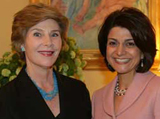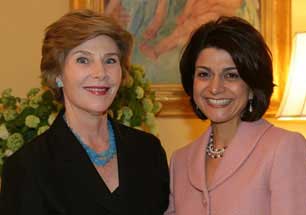
03.30.05 – On March 30, First Lady Laura Bush and Secretary of Education Margaret Spellings visited Afghanistan for six hours to inspect the progress of several education initiatives and announce US financial support for two new projects. They were accompanied on the ground by Under Secretary of State for Global Affairs Paula Dobrianski and a delegation from the US Afghan Women’s Council.
 Six hours doesn’t sound like a long time, but the First Lady managed to squeeze in a lot during her brief time in Afghanistan. She met with Afghan President Hamid Karzai and First Lady Dr. Zenat Karzai. She visited the US-funded National Women’s Dormitory at Kabul University, where she delivered a speech. She toured two classrooms at the Women’s Teacher Training Institute and participated in a roundtable with teachers and trainers from the institute. She visited an exhibit at the Afghan Women’s Business Council, and also managed to fit in a visit to the Bagram Air Base in Kabul.
Six hours doesn’t sound like a long time, but the First Lady managed to squeeze in a lot during her brief time in Afghanistan. She met with Afghan President Hamid Karzai and First Lady Dr. Zenat Karzai. She visited the US-funded National Women’s Dormitory at Kabul University, where she delivered a speech. She toured two classrooms at the Women’s Teacher Training Institute and participated in a roundtable with teachers and trainers from the institute. She visited an exhibit at the Afghan Women’s Business Council, and also managed to fit in a visit to the Bagram Air Base in Kabul.
Present in Afghanistan to accompany the First Lady throughout her visit was Mrs. Shamim Jawad, wife of Afghanistan’s Ambassador to the United States. DiplomaticTraffic.com had the opportunity to speak with Mrs. Jawad about the First Lady’s visit.
DiplomaticTraffic.com: First of all, can you tell me a little about the purpose of this trip?
Shamim Jawad: The First Lady’s visit to Afghanistan was one of the most important and historic visits for the people of Afghanistan. The First Lady wanted to show her support and commitment for Afghan women. She had wanted to do this trip for two years. President Karzai told Mrs. Bush that “your visit matters much more than hundreds of millions of dollars.”
Afghan women who met the First Lady were trilled. They could not believe that only four years after the fall of Taliban, they were standing face to face with one of the most caring and powerful women of the world.
The Bush administration has pledged $80 million to Afghan education. Can you tell me how this money will be allocated, and the time frame for each project?
American pledges are for a specific fiscal year, in this case fiscal year ’05. The actual money that the United States is spending is in fact more than that amount. Currently, USAID is involved in building and repairing schools, training teachers, printing text books and improving the curriculum, providing special education and vocational training, and literacy programs.
I understand there is a pledge of $15 million to establish the American University of Afghanistan and $3.5 million towards establishing the International School of Afghanistan. Can you tell me a little more about these projects?
The Afghans have been asking for an American University for the past two years. During this trip the Memorandum of Understanding was signed. The university will offer business management, technology and professional curricula in English, with an international faculty. Scholarship will be offered to women who can’t afford the $5000 annual tuition. The first students are expected in 2006. The International School of Afghanistan will offer a first-rate education for grades K-12. Construction for both schools will start shortly.
There is a dire need for teachers in remote and rural communities. Can you tell me about The Women’s Teacher Training Institute’s program, The Afghan Literacy Initiative, to accelerate literacy, math and life skills in remote rural communities?
The Women’s Teacher Training Institute was an initiative by the First Lady to educate teachers especially for the rural areas. The initiative came from her desire to see young girls in Afghanistan receive an education. When Mrs. Bush found out how badly we need trained teachers, she personally took it upon herself to help establish a Women’s Teacher Training Institute in Kabul, with the help of the US-Afghan Women’s Council. The Institute is designed to help teach basic literacy to Afghan women in rural areas. It started in September of 2004 and 200 women from rural areas are now enrolled in the Afghan Literacy Initiative program.
Under the Taliban, Afghan women were denied education. How large a percentage of Afghan girls and women receive primary education today?
Around 5.4 million children, about half of Afghanistan’s school-age children, are now in school. Thirty-eight percent of these schoolchildren are girls. There is a huge need for facilities in the rural areas. Only 29 percent of our schools have roofs, but the need for qualified teachers is even greater.
There was a woman candidate in the presidential race. In what ways are you noticing increased participation by women in Afghan society and how is this participation perceived?
Indeed, we had our first woman candidate in the presidential race. She is now our Minister of Women’s Affairs. Every time I visit Afghanistan I witness enormous progress from the previous time, especially in the area of women’s issues. Now women are fully participating in all social, economic and political aspects of life in Afghanistan. They are determined and articulate about what they want. During the Taliban period women were denied all basic rights, but now the men understand the importance of equal rights for women. It will take some time for Afghan women to catch up and realize their legal rights, but I know we will get there.
What can you do to encourage participation of women in all aspects of Afghan society, not just in the capital, and not just in politics, but as leaders in all sectors of society?
In Afghanistan we have good laws governing women’s rights, but those laws don’t mean anything if women are not educated about their rights. The key is education and the more educated women in rural areas become, the more participation by women we will have. Increased participation can be reached only by investing in women’s education. I support a number of initiatives by the government that provides education and training for Afghan women.
In our interview with your husband last year, one recurring theme was the insufficient aid Afghanistan was receiving. How is this lack of funds to combat typically female problems, like death by childbirth, affecting women in Afghanistan?
We appreciate the support we are receiving from the United States, but we still face tremendous challenges. Maternal and infant mortality rates are the highest in rural areas of Afghanistan. We need more trained doctors and nurses, but above all we need trained midwives. The US-Afghan Women’s Council has a Midwife Training program called REACH which provides health-related and basic literacy training for women and girls. In April of last year, the first graduating class of 25 midwives could go back to rural areas to practice. It’s important to train women from the villages who will return after their training and practice in these areas. There is no access to trained doctors and medical facilities in these areas and often men are hesitant to let their wives see male doctors. That’s why there is a need to train more midwives.
Mrs. Bush is herself a teacher. Can you tell me a little about her personal involvement in the education projects in Afghanistan?
Mrs. Bush understands the importance of education and the lifeline that education is. As I mentioned before, the Women’s Teacher Training Institute was a special initiative by Mrs. Bush to educate Afghan girls. This year, six million Afghan children will attend school thanks to US assistance. I appreciate the personal commitment of the First Lady. She is trying to help us in the area that we need the most assistance, education.
Did the First Lady mention anything about the trip afterwards?
We had very little time at the end, but I think she enjoyed being with women and being able to witness for herself the progress of education in Afghanistan. I think she found it inspiring to see the interest men and women have in education for themselves and for their children. She also visited a number of bakeries and met with children on the streets of Kabul. This was very important and sends a strong message that Afghanistan is now a safe place.
I also know that she was thrilled to meet with young women who were studying to become teachers and Afghan businesswomen who now support their families through their own businesses.
In order to achieve some degree of gender equality, women must be economically empowered. If a woman has a job and has a source of income, she will enjoy more respect and be able to defend her rights.
Today some Afghan women are running businesses in very male-dominated sectors, such as construction. It is important to provide women with skills, training and most importantly with access to capital and loans.
It is a great source of inspiration for Afghan women, who have come a very long way the last four years, to see the First Lady of the United States recognize their achievements and support their struggle.
We are only a few years removed from the rule of the terrorists, when women were denied education and every basic human right. That tyranny has been replaced by a young democracy, and the power of freedom is on display across Afghanistan.
Mothers and fathers alike in Afghanistan understand the value of education. It was the Taliban that forced parents to keep their daughters at home. Afghanistan is now going back to what it was, Mrs. Shamim Jawad concluded.
